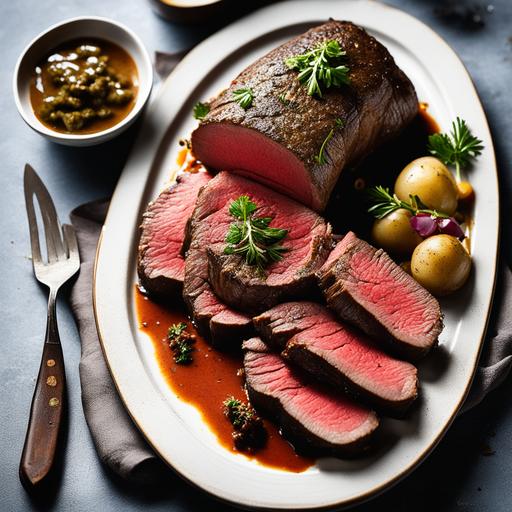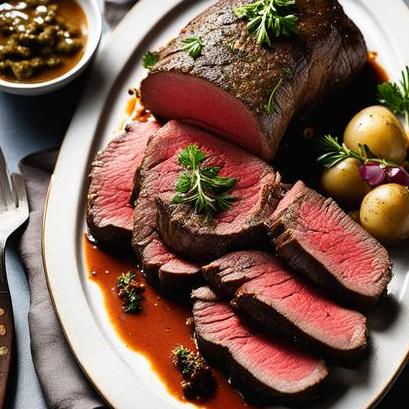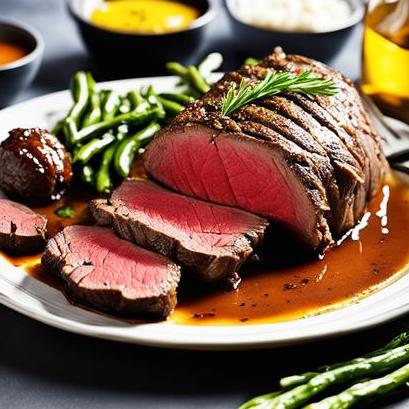
The Magnificent Whole Beef Tenderloin Oven Recipe: A Journey Into Culinary Perfection
Nothing quite matches the elegance and indulgence of a perfectly cooked whole beef tenderloin straight from the oven. This revered cut, also known as filet mignon, is prized for its outstanding tenderness and melt-in-your-mouth texture. Whether you’re hosting a special occasion or simply wanting to elevate your culinary skills, this comprehensive guide will walk you through every aspect of preparing the ultimate whole beef tenderloin oven recipe. From the food science behind its succulence to the selection, cleaning, preparation, cooking tips, variations, doneness checks, and a mouthwatering recipe, prepare yourself for an exploration of culinary perfection.
The Science of Succulence: Understanding the Culinary Magic
The whole beef tenderloin, located beneath the backbone, is a muscle rarely used by the animal, resulting in exceptional tenderness. It is naturally low in fat marbling, making it incredibly lean. The lack of fat, however, can pose a challenge during the cooking process as it can lead to dryness. Fear not! We will unlock the secrets to an impossibly moist and flavorful beef tenderloin through meticulous preparation and precise cooking techniques.
Selecting the Perfect Beef Tenderloin: A Cut Above the Rest
When embarking on the journey of creating a sublime whole beef tenderloin, choosing the right cut is paramount. Look for a tenderloin with a vibrant reddish hue and a fine marbling of fat. The fat serves as a flavor enhancer, adding to the succulence of the meat. Opt for USDA Prime or Choice grades, as they guarantee superior tenderness and flavor.
Cleaning and Preparing the Beef Tenderloin: A Pristine Canvas

Before diving into the cooking process, cleanliness is essential. Begin by rinsing the tenderloin under cold water to remove any residual blood or impurities. Pat it dry with paper towels, ensuring there is no excess moisture. This step sets the stage for a flawless preparation.
Next, it’s time to trim the tenderloin. While this cut is typically lean, it may still have areas of connective tissue or excess fat that can affect the final dish. Using a sharp knife, carefully remove any sinew or fat, being cautious not to over-trim. It is best to maintain a thin layer of fat to enhance flavor. Once trimmed, the tenderloin is now ready to be transformed into a culinary masterpiece.
Cooking Tips and Techniques: Unlocking the True Essence

Preparing a whole beef tenderloin requires precision and attention to detail. By following these expert tips and techniques, you can ensure a succulent and perfectly cooked tenderloin every time:
-
Bring the meat to room temperature: Allow the beef tenderloin to sit at room temperature for about 30 minutes before cooking. This promotes even cooking and prevents the outer edges from overcooking while achieving the desired internal doneness.
-
Season to perfection: Generously season the tenderloin with kosher salt and freshly ground black pepper. The simplicity of this seasoning allows the beef’s natural flavors to shine.
-
The searing secret: Before transferring the tenderloin to the oven, sear it in a hot skillet with a drizzle of oil. This step creates a delightful caramelized crust that adds depth and richness to the final dish. Sear each side for approximately 2 minutes until nicely browned.
-
Choosing the right roasting pan and rack: Opt for a heavy-duty roasting pan with a rack to elevate the beef. The rack ensures even heat distribution and prevents the tenderloin from sitting in its juices, promoting a crispy exterior.
-
Basting brilliance: Basting the beef tenderloin with melted butter or a flavorful marinade during the cooking process helps to retain moisture and infuse additional flavors. Baste every 15-20 minutes for optimal results.
-
Harnessing the power of thermometers: To achieve the perfect doneness, invest in a meat thermometer. For a medium-rare tenderloin, aim for an internal temperature of around 135°F (57°C). Remember, the temperature will rise a few degrees during resting.
Checking for Doneness: The Art of Precision

Determining the doneness of your whole beef tenderloin can be achieved through various methods. Here are a few reliable techniques to consider:
-
Meat Thermometer: Insert a meat thermometer into the thickest part of the tenderloin, avoiding contact with bone or fat. The desired internal temperature for medium-rare is 135°F (57°C), 140°F (60°C) for medium, and 150°F (66°C) for medium-well. Be mindful that carryover cooking will occur during resting.
-
Touch Test: Gently press on the surface of the tenderloin with your fingertips. The softer the meat feels, the rarer it is. As you progress towards medium-well, the meat becomes firmer.
-
Color Clues: If you prefer a visual cue, the color of the meat can indicate its doneness. For medium-rare, aim for a warm pink center, transitioning to a slightly darker pink for medium, and a slightly pinkish-gray center for medium-well.
Remember, practice and experience will fine-tune your ability to determine the doneness of the beef tenderloin with confidence.
The Quintessential Whole Beef Tenderloin Oven Recipe: A Symphony of Flavors

Without further ado, here is a tantalizing recipe that showcases the exceptional qualities of a whole beef tenderloin:
Ingredients:
-
1 whole beef tenderloin (approximately 4-5 pounds)
-
Kosher salt and freshly ground black pepper (to taste)
-
4 tablespoons unsalted butter, melted
-
Optional: Fresh herbs (such as rosemary or thyme) for garnish
Instructions:
-
Preheat your oven to 425°F (218°C).
-
Season the entire beef tenderloin generously with kosher salt and freshly ground black pepper, ensuring an even coating.
-
Heat a skillet over high heat and add a drizzle of oil. Carefully sear the beef tenderloin on all sides until golden brown, approximately 2 minutes per side.
-
Place a roasting rack in your heavy-duty roasting pan and transfer the seared beef tenderloin onto the rack.
-
Drizzle the melted butter over the tenderloin, ensuring it is evenly coated.
-
Place the roasting pan in the preheated oven and cook for approximately 25-30 minutes. Baste with melted butter or marinade every 15-20 minutes to keep the meat moist and flavorful.
-
Begin checking for doneness using a meat thermometer or other preferred method. For medium-rare, aim for an internal temperature of 135°F (57°C).
-
Once the desired doneness is achieved, remove the beef tenderloin from the oven and tent it loosely with foil. Allow it to rest for 15-20 minutes to allow the juices to redistribute.
-
Slice the rested beef tenderloin into thick medallions and serve garnished with fresh herbs if desired.
Elevating Your Culinary Experience: Delicious Variations Worth Exploring
While the classic whole beef tenderloin oven recipe is a culinary masterpiece in itself, exploring variations adds an exciting touch to your dining experience. Here are a few delightful options to consider:
-
Herb-Crusted Delight: Before searing, coat the beef tenderloin with a mixture of finely chopped fresh herbs, garlic, and olive oil. This imparts a fragrant herbaceous crust that beautifully complements the tenderloin’s natural flavors.
-
Bacon-Wrapped Bliss: Indulge in ultimate decadence by wrapping the seasoned beef tenderloin with bacon slices before searing. The bacon adds smoky richness and keeps the tenderloin moist and succulent throughout the cooking process.
-
Gourmet Mushroom Duxelles: Prepare a delightful mushroom duxelles by finely chopping a mixture of mushrooms, shallots, garlic, and herbs. Sauté the mixture until tender and spread it generously over the seared tenderloin before roasting. The earthy flavors of the mushrooms create a sublime pairing with the beef.
In Conclusion: A Culinary Masterpiece Awaits
From understanding the science behind its succulence to selecting, preparing, cooking, checking for doneness, and exploring variations, this comprehensive guide has equipped you with the knowledge and inspiration to embark on the journey of creating the perfect whole beef tenderloin oven recipe. Remember, practice makes perfect, and with time, you will master the art of culinary perfection. So, don your apron, gather your ingredients, and embrace the luxurious adventure that awaits you in your kitchen. Bon appétit!
Sources
FAQS On Whole Beef Tenderloin Oven Recipe
What Is A Whole Beef Tenderloin?
A whole beef tenderloin is a long, cylindrical cut of beef that comes from the loin area of the cow. It is a very tender and flavorful cut that is often used for special occasions.
How Should I Prepare A Whole Beef Tenderloin For The Oven?
Before cooking a whole beef tenderloin in the oven, it is important to remove any silver skin and excess fat from the meat. You can do this by using a sharp knife to carefully trim off the unwanted portions.
What Temperature Should I Cook A Whole Beef Tenderloin In The Oven?
It is recommended to cook a whole beef tenderloin in the oven at a temperature of 425°F. This high temperature will help to sear the outside of the meat, creating a delicious crust while keeping the inside tender and juicy.
How Long Should I Cook A Whole Beef Tenderloin In The Oven?
The cooking time for a whole beef tenderloin in the oven will vary depending on the weight of the meat and the desired level of doneness. A good estimate is to cook the beef for 25-30 minutes per pound for rare to medium-rare, and 30-35 minutes per pound for medium to well-done.
How Can I Tell When A Whole Beef Tenderloin Is Cooked To The Right Temperature In The Oven?
The best way to determine if a whole beef tenderloin is cooked to the right temperature in the oven is to use a meat thermometer. Insert the thermometer into the thickest part of the meat, making sure to avoid any bone or fat. The internal temperature should read 120°F for rare, 130°F for medium-rare, 140°F for medium, and 150°F for well-done.



